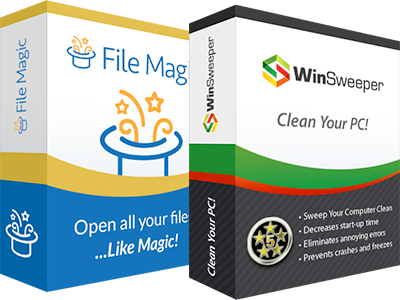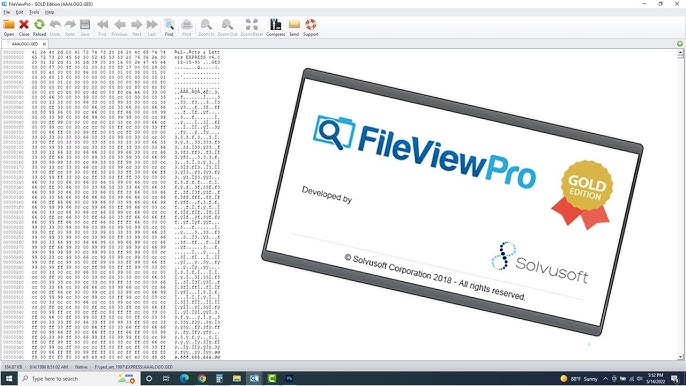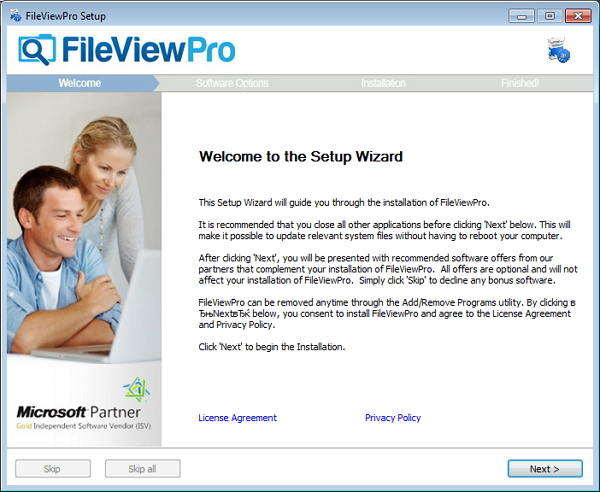 FileMagic is a comprehensive and user-friendly file management software designed to simplify the process of opening, viewing, and managing a wide range of file formats. Among the many file types it supports, FileMagic offers powerful functionality for handling PEA files, an advanced archive format known for its strong encryption and data integrity features. With an emphasis on accessibility, security, and efficiency, FileMagic eliminates the hassle of dealing with incompatible file formats, allowing users to open and extract PEA files with ease. Whether you are a professional handling secure data, a business user managing compressed archives, or an everyday user who has encountered a PEA file for the first time, FileMagic provides a seamless solution that removes the need for multiple software programs.
FileMagic is a comprehensive and user-friendly file management software designed to simplify the process of opening, viewing, and managing a wide range of file formats. Among the many file types it supports, FileMagic offers powerful functionality for handling PEA files, an advanced archive format known for its strong encryption and data integrity features. With an emphasis on accessibility, security, and efficiency, FileMagic eliminates the hassle of dealing with incompatible file formats, allowing users to open and extract PEA files with ease. Whether you are a professional handling secure data, a business user managing compressed archives, or an everyday user who has encountered a PEA file for the first time, FileMagic provides a seamless solution that removes the need for multiple software programs.
PEA files, or **Pack Encrypt Authenticate** files, are primarily used for secure data storage and transmission. Developed by the PEA Project, this format is designed with encryption and compression in mind, making it an ideal choice for users who need to protect their sensitive data. Unlike traditional archive formats such as ZIP or RAR, PEA files include built-in encryption and authentication features that ensure data integrity and prevent unauthorized access. However, opening a PEA file can be challenging for users who do not have the appropriate software installed. Many operating systems and file management tools do not natively support this format, which can lead to frustration when attempting to access important files. FileMagic addresses this issue by providing a reliable and intuitive way to open, view, and extract PEA files without requiring additional third-party software.
When a user opens a PEA file in FileMagic, the software presents a well-organized and visually intuitive interface that makes it easy to navigate the contents of the archive. Unlike other file management programs that simply list files without context, FileMagic ensures that users can clearly see the structure of the archive, including nested folders, encrypted sections, and metadata such as file size and creation date. This structured view allows users to quickly identify and extract the files they need without unnecessary complexity. For users handling encrypted PEA files, FileMagic provides a straightforward decryption process that ensures secure access to the contents without compromising data integrity.
One of the standout features of FileMagic when working with PEA files is its ability to handle password-protected archives. Because PEA files are often used for security purposes, many of them require a password to access their contents. FileMagic simplifies this process by allowing users to enter their credentials directly within the software, unlocking the encrypted files with minimal effort. Unlike other file management tools that require separate decryption steps or additional software installations, FileMagic integrates this functionality seamlessly into its interface, saving users time and ensuring that they can access their files efficiently.
File verification is another critical feature of FileMagic when dealing with PEA files. Because these archives are designed to include authentication mechanisms, FileMagic can perform integrity checks to ensure that the contents have not been altered or corrupted. This is particularly valuable for businesses and organizations that rely on secure file transfers, as it provides an added layer of assurance that the data they are receiving or storing is authentic and unmodified. By using FileMagic, users can confidently verify the integrity of their PEA files before extracting or sharing them.
Performance is a key consideration when working with encrypted and compressed files, and FileMagic excels in this area. Unlike some archive management tools that struggle with large or complex files, FileMagic is optimized to handle PEA files efficiently, ensuring quick loading times and smooth navigation. This makes it an excellent choice for users who frequently work with large archives or need to process multiple files at once. Whether extracting a single file or an entire archive, FileMagic ensures a fast and responsive experience.
Beyond its functionality for opening and extracting PEA files, FileMagic also provides previewing capabilities that allow users to inspect the contents of an archive without extracting the files. This feature is particularly useful when dealing with unknown or unfamiliar files, as it allows users to see what is inside a PEA archive before deciding whether to extract specific files. By providing a quick and easy way to preview archive contents, FileMagic helps users save time and avoid unnecessary file extractions.
Cross-platform compatibility is another significant advantage of FileMagic. Unlike some file management software that is limited to specific operating systems, FileMagic is designed to work seamlessly across Windows, macOS, and Linux. For more information in regards to file extension PEA look into the internet site. This ensures that users can open and manage their PEA files regardless of the device they are using. Whether working on a desktop, laptop, or even a remote workstation, users can rely on FileMagic to provide a consistent and reliable experience. This cross-platform functionality is particularly valuable for teams that collaborate across different operating systems, as it allows them to share and access PEA files without compatibility issues.
FileMagic also integrates with cloud storage services, allowing users to access their PEA files directly from platforms such as Google Drive, Dropbox, and OneDrive. This feature enhances workflow efficiency by eliminating the need to download and manually extract files before viewing their contents. Instead, users can open and manage their PEA archives directly within FileMagic, regardless of where they are stored. This is especially beneficial for remote workers, IT professionals, and businesses that rely on cloud-based storage solutions.
Security is a top priority for FileMagic, particularly when handling encrypted archives like PEA files. The software includes robust security measures to ensure that sensitive data remains protected at all times. Users can set permissions to restrict file access, enabling them to control who can open, view, or extract the contents of a PEA file. Additionally, FileMagic’s encryption support ensures that password-protected files remain secure throughout the extraction process. These security features make FileMagic an ideal solution for users who need to manage confidential data without compromising on ease of access.
Customer support is another area where FileMagic excels. The software includes extensive documentation, tutorials, and an active support team to assist users with any issues they encounter. Whether users need help opening a PEA file, troubleshooting an error, or understanding encryption settings, FileMagic provides comprehensive guidance. This commitment to customer satisfaction ensures that users can maximize the benefits of the software without unnecessary frustration.
Regular software updates keep FileMagic at the forefront of file management technology. The development team continuously improves the software, adding support for new file formats and enhancing existing features. This ensures that FileMagic remains compatible with evolving file standards and continues to provide users with a reliable and up-to-date file management solution. By staying ahead of technological advancements, FileMagic continues to offer a robust and versatile platform for handling a wide range of file formats.
In summary, FileMagic is a powerful and versatile file management solution that excels in handling PEA files. With its ability to open, view, and extract encrypted archives, FileMagic provides users with a seamless and secure way to manage important files. The software’s intuitive design, cross-platform compatibility, and cloud integration make it an essential tool for both personal and professional use. Whether managing secure data transfers, verifying file integrity, or simply opening a compressed archive, FileMagic delivers the functionality and reliability needed to streamline file management tasks. By eliminating compatibility issues and enhancing security, FileMagic empowers users to access their files effortlessly and efficiently.
 This is particularly useful for musicians and live performers who need to understand how different sounds will respond to their playing. By offering a clear view of program structures, FileViewPro allows users to fine-tune their performances and optimize their use of sample-based instruments. For professionals who frequently collaborate on music projects, FileViewPro offers flexible file export and sharing options.
This is particularly useful for musicians and live performers who need to understand how different sounds will respond to their playing. By offering a clear view of program structures, FileViewPro allows users to fine-tune their performances and optimize their use of sample-based instruments. For professionals who frequently collaborate on music projects, FileViewPro offers flexible file export and sharing options. However, AKP files can be challenging to open and manage without access to compatible Akai hardware or software. FileViewPro provides a solution by allowing users to easily open and analyze AKP files, making it possible to inspect and understand the contents of these files without specialized equipment. When users open an AKP file with FileViewPro, they gain immediate access to its full contents, including the audio samples, metadata, and program structure stored within the file.
However, AKP files can be challenging to open and manage without access to compatible Akai hardware or software. FileViewPro provides a solution by allowing users to easily open and analyze AKP files, making it possible to inspect and understand the contents of these files without specialized equipment. When users open an AKP file with FileViewPro, they gain immediate access to its full contents, including the audio samples, metadata, and program structure stored within the file. FileMagic is a comprehensive and user-friendly file management software designed to simplify the process of opening, viewing, and managing a wide range of file formats. Among the many file types it supports, FileMagic offers powerful functionality for handling PEA files, an advanced archive format known for its strong encryption and data integrity features. With an emphasis on accessibility, security, and efficiency, FileMagic eliminates the hassle of dealing with incompatible file formats, allowing users to open and extract PEA files with ease. Whether you are a professional handling secure data, a business user managing compressed archives, or an everyday user who has encountered a PEA file for the first time, FileMagic provides a seamless solution that removes the need for multiple software programs.
FileMagic is a comprehensive and user-friendly file management software designed to simplify the process of opening, viewing, and managing a wide range of file formats. Among the many file types it supports, FileMagic offers powerful functionality for handling PEA files, an advanced archive format known for its strong encryption and data integrity features. With an emphasis on accessibility, security, and efficiency, FileMagic eliminates the hassle of dealing with incompatible file formats, allowing users to open and extract PEA files with ease. Whether you are a professional handling secure data, a business user managing compressed archives, or an everyday user who has encountered a PEA file for the first time, FileMagic provides a seamless solution that removes the need for multiple software programs.